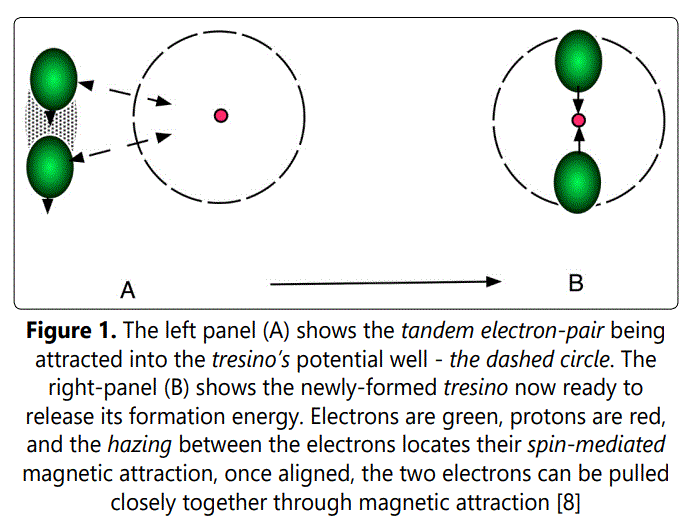Letter to Editor
How the Tresino phase-transition is driven to ignite Coronal Mass Ejections
Mayer Applied Research Inc., USA
*Corresponding author: Frederick J. Mayer, Mayer Applied Research Inc. 1417 Dicken Drive, Ann Arbor, MI 48103, USA, E-mail: fred@frederickjmayer.net
Received: May 22, 2023 Accepted: May 31, 2023 Published: June 06, 2023
Citation: Mayer FJ. Initiating Tresino PhaseTransitions in Laboratory Hydrogen-Plasmas. Int J Cosmol Astron Astrophys. 2023; 5(1): 202-204. doi: 10.18689/ijcaa-1000137
Copyright: © 2023 The Author(s). This work is licensed under a Creative Commons Attribution 4.0 International License, which permits unrestricted use, distribution, and reproduction in any medium, provided the original work is properly cited.
Abstract
This letter describes the crucial role tresino phase-transitions and a second Compton-scale composite play in generating coronal mass ejections (CMEs).
Keywords: Tresinos, compton composites, coronal mass ejections
History and Introduction
Twenty-some years ago, my late colleague John Reitz and I published a paper [1] that described a new Compton- scale composite particle; we called it a tresino. As explained in previous papers, a tresino is a composite of two electrons closely bound to a proton in a balance between electrostatic and dipole-dipole magnetic forces. We later examined how this composite might play a role in the heat from the earth [2] and its possible role in cosmology [3]. In the latter paper we noted that because of its plasma characteristics, tresinos could play a role in the solar corona as well.
Readers unfamiliar with tresinos might benefit from reading the Introduction to my paper “Hidden Baryons” [4] because tresinos are crucial to understanding the physics in this letter; the Introduction includes a basic classical derivation of the tresino composite system.
After John passed away, I continued examining the possibilities of the tresino phase-transitions in the Sun in a series of papers beginning with [5], a paper that identified where the phase-transitions could be expected from the large solar observational data files of Avrett and Loeser, specifically their Model C7 of the quiet Sun. That paper was later followed by [6] that pointed out the important role that Debye spheres could play in the corona’s instabilities, a topic further discussed below. In this letter, I show how the tresino phase-transition, activated beneath the solar surface, initiates a number of complex phenomena including coronal mass ejections (CMEs) that have been difficult to explain for decades without the formation energy (3.7 keV) of the tresino and a second Compton composite one that I have called tandem electron-pairs.
This letter reviews and then expands upon our prior work on the corona’s connection to tresino phase-transition physics.
Significance of Debye Spheres
Each Debye sphere has a proton at its center somewhat insulated by equilibrium electrostatic fields of the surrounding electron clouds. Now notice that solar observational data I examined in [5] found that the plasma at 2350 km beneath the solar surface may be either quiet or active under different circumstances; here I will show how this might happen. In [5] I showed that the plasma parameters for the quiet Sun were found to be ne = 1.6 109 and Te = 17.5 eV. Furthermore, the electron temperature is expected to be higher in the active Sun.
Next notice that the electron temperature determines the “classical distance of closest approach” in the scattering of an electron [7] from the centrally located proton in a Debye sphere. This distance is only 213 λc in the quiet Sun. For the proton to make the transition into a tresino would require two such electrons to simultaneously be within the tresino’s potential well. In our QM model of the tresino, we estimated [1] that the potential well diameter of larger than about 40 λc .
This suggests that Te ≥100 eV would be required for two such electrons to be within the potential-well simultaneously to convert the proton into a tresino, a rather large increase above the temperature of the background plasma. However, there is an alternate possibility, now described, that has the same effect, namely a pair of connected electrons.
Tandem Electron-Pairs
From our earliest consideration of Compton composites [1], we often asked the question how do tresinos acquire their two electrons?” In a recent paper [8], I found one such answer, namely that electrons, under certain conditions, can pair-up” as another basic Compton composite, especially as tandem electron-pairs. FIG 1. illustrates how this can happen. In the left-panel (A) a tandem electron pair has been formed and penetrates the electron cloud of the Debye shield and is then attracted to the proton surrounded by its potential well, the dashed circle, of the Debye sphere. In the right panel (B) the tresino has been formed and then releases its formation energy (3.7 keV).
Toward Ignition
In [6] I estimated the energy released in large-scale solar explosive events, driven by the tresino phase-transitions. It appears that to generate such large amounts of energy requires an explosion driven in a manner similar to that of chemical explosives, i.e., similar to detonation waves. This sort of reaction is possible due to the fact that individual Debye spheres are so close together – less than about 0.0009 cm. So, it appears that this is a new type of detonation wave driven by tandem electron-pairs where the wave proceeds when a tresino forms, releasing its binding energy, and delivers another tandem electron-pair to a close-by proton in its protective Debye sphere.

Triggers
There may be a number of mechanisms that can trigger the ignition of the tresino phase-transitions, (those within the appropriate tresino phase-transition zone). All of them must first generate a tandem electron-pair in order to be captured by the proton at the center of a Debye sphere, as depicted in FIG.1. The situation that seems most likely is via the electron streams generated by magnetic-field reconnections [9, 10] within the tresino phase-transition zone. A second trigger mechanism is possible when the Debye spheres undergo thermally-driven instability such as a burst of electron heating from a newly formed, close-by, tresino that has just released its 3.7 keV of binding energy. The Debye sphere can be driven unstable and tries to return to electrostatic stability by increasing the total electron numbers (see the basic calculation in [6]) from its nominal value by a new, much larger number of electrons (note the rapid increase of Ne in FIG. 2 of [6]). Some of these newly created electrons could then “pair up” becoming a tandem electron-pair. Notice that this sequence is clearly suggestive of a type of chain reaction in near-by Debye spheres producing the large energy releases.
Entrainment
As just mentioned, magnetic-field reconnection may trigger the explosive energy release of the tresino phase-transitions at the depth of 2350 km below the solar surface. Furthermore, the currents and magnetic fields in this region can be entrained by the explosion that it initiates. If the energy release is sufficiently large, a section of magnetic-field ropes (probably anchored at the reconnection point) as well as plasma can be carried out by the explosion up through the corona and become visible as coronal loops [11]. Such loops are, of course, frequently observed on the Sun but their origin has been difficult to understand for many years.
Closing Comments
The important understanding in this letter is that the lesser known Compton composites, tandem electron-pairs, are required to drive the observed detonation-like character of the CMEs. The extremely large scales of some CMEs, themselves, suggest that some sort of phase-transition such as the tresino phase-transition must be involved. Perhaps some other mechanism is possible. However, if this is the case, there remain many connections that will have to be understood similar to those that I have presented in this letter.
Of course, many theoretical and observational studies will be required before this theory may be confirmed as the source of CME generation.
Dedication
I dedicate this paper to my late mentor, collaborator, and friend, Dr. John R. Reitz, without whose efforts this work would not have become possible.
References
- Frederick J. Mayer, John R. Reitz. Electromagnetic Composites at the Compton Scale. Int J Theor Phys. 2012; 51: 322-330. doi:10.1007/s10773-011-0959-8
- FJ Mayer, JR Reitz. Thermal energy generation in the earth. Nonlin Processes Geophysics. 2014; 21: 367-378. doi:10.5194/npg-21-367-2014
- Frederick Mayer, John Reitz. Compton Composites Late in the Early Universe. Galaxies. 2014; 2: 382-409. doi:10.3390/galaxies2030382
- FJ Mayer. Hidden baryons: The physics of Compton composites. Europhysics Letters. 2016; 114(6): 69001-69007. doi: 10.1209/0295- 5075/114/69001
- FJ Mayer. The Phase-Transition Beneath the Solar Surface. Int J Cosmol Astron Astrophys. 2021; 3(1): 121-124. doi: 10.18689/ijcaa-1000125
- FJ Mayer. The Physics of the Tresino Phase-Transition beneath the Solar Surface. Int J Cosmol Astron Astrophys. 2023; 4(1): 158-160. doi: 10.18689/ijcaa-1000129
- FJ Mayer. Spin-Mediated Electron Pairing. Int J Phys Stud Res. 2021; 4(1): 95-97. doi: 10.18689/ijpsr-1000115
- Marina Battaglia, Eduard P Kontar, Galina Motorina. Electron distribution and energy release in magnetic reconnection outflow regions during the pre-impulsive phase of a solar flare. 2019; doi: 10.48550/arXiv.1901.07767
- LHM Rouppe van der Voort, J Joshi, VMJ Henriques, S Bose. Signatures of ubiquitous magnetic reconnection in the deep atmosphere of sunspot penumbrae. 2021; 10.48550/arXiv.2101.11321
- Coronal Loops in an Active Region of the Sun. 2014; NASA.


